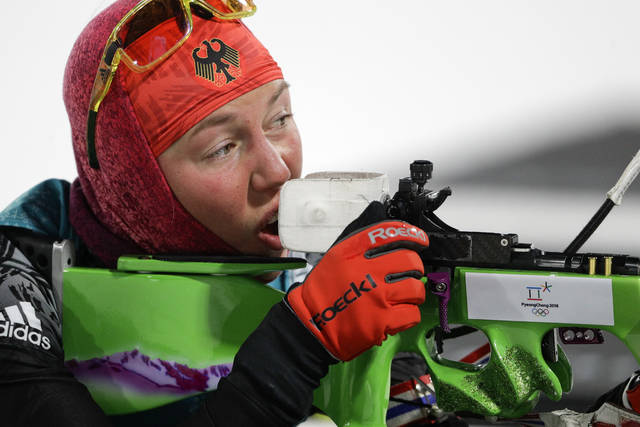PYEONGCHANG, South Korea — Laura Dahlmeier was laying on the frozen ground at the Olympics, blocking out the glare of the lights from above, blocking out the bitter 10-degree temperature and the gusts of wind, and fired five shots from her .22-caliber small-bore rifle at a target 50 meters away.
The German biathlete hit all five of the silver dollar-sized targets, then tossed the gun on her back and strode off on her skis against the backdrop of a night sky.
Easy for a biathlete who won five of six events at the world championships last year, but certainly not so easy for everyone.
As if the biathlon — a sport that mixes the endurance and speed of cross-country skiing with the focus and precision of shooting a rifle — isn’t already difficult enough, it just got tougher. Biathletes at the Pyeongchang Games will have additional challenges to contend with over the next two weeks at the Winter Games, including shooting under floodlights at night when temperatures are colder and the wind gustier.
Of the 11 biathlon events at the Pyeongchang Games, eight of them will be held at night.
That means bitter cold, wind and artificial light.
The wind is especially tricky for biathletes. Unlike some other Olympic events in Pyeongchang, there is no net set up to stop it.
Dahlmeier, the sport’s rising star, managed the conditions just fine on Saturday night, taking home gold in the women’s 7.5-kilometer sprint after hitting all 10 of her targets. But she collapsed to the ground exhausted after what she called a “perfect race.”
“There was a lot of wind and the cold temperature, certainly not the easiest conditions,” Dahlmeier said. “I had to stay focused and do the right things.”
Of the 86 participants in Saturday night’s race, only three hit all 10 targets. Unlike Dahlmeier, the other two did not place in the top 15.
While Dahlmeier managed the conditions well, American rival Susan Dunklee did not.
Dunklee, who won gold and silver at the world championships last year to put herself in position to contend for an Olympic medal, missed five targets and finished a distant 66th.
Dunklee called it “frustrating,” knowing that her poor performance prevented her from qualifying for the pursuit race on Monday.
“You work for four years and you have big dreams to see what’s possible and it all comes down to one of these races like this,” Dunklee said. “The sprint is so important for the rest of the races here. You really have to have a good sprint to qualify for the pursuit, to qualify for the mass start, so I’m really bummed about that.”
Emily Dreissigacker was the best American finisher, taking 51st place after hitting nine of 10 targets.
But she said it wasn’t easy.
“It was very windy for the shooting,” Dreissigacker said. “In prone (position) I definitely got kind of lucky and the wind was about the same as what I had zeroed in. And then in standing, I could feel the wind pushing my barrel around a little bit.”
Silver medalist Marte Olsbu of Norway called the course “difficult” because of the wind on the shooting range. There should be more of that to come as the Olympics continue.
“It’s going to be a challenge,” Dahlmeier said of the conditions, “but it’s the same for everyone.”
———
More AP Olympics: https://wintergames.ap.org


